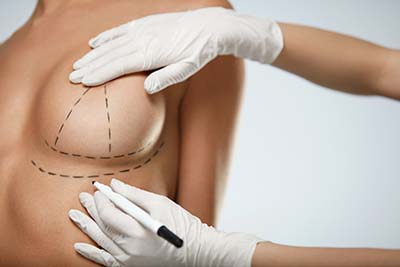Breast augmentation, also known as mammoplasty, is a surgical procedure designed to increase the size of the breasts using fat transfer or breast implantation.
Summary Info;
How long does it take? 2 hours on average.
Type of anesthesia: General Anesthesia
Side effects: Pain, incision scarring in operations using prosthesis, edema
Risks: infection, scarring, bleeding, leakage, general anesthesia risks, long-term wear and tear of the silicone prosthesis, capsular contracture
Recovery time: Complete recovery is completed in 2-4 weeks on average
Return to work: 5-7 days
Success rate: 89
Anatomy of the Breast
A breast is made up of 15-20 sections called lobes, which in turn contain smaller lobules that produce milk. Ducts carry milk from the lobules to your nipple. It is surrounded by fatty tissue and filled with blood vessels, lymph nodes, connective tissues.
However, breasts usually finish growing by the late teens to early twenties. The breasts are fully developed around the age of 18.

Breast Augmentation Techniques
Fat Injection
It is a method of breast augmentation with one’s own fat tissue. Since fat cells already belonging to the patient are used in the operation, there is no risk of allergic reaction. The fat cells taken by liposuction method in areas such as the abdomen, waist and hips where the fat cells of the person are excessive are injected into the breasts through special processes such as washing and plumping is provided.
Since the amount of fat that can be removed may be insufficient in thin people, it is not preferred in thin people. In people whose fat amount is sufficient, it is a very efficient application as it provides both some thinning in the area where fat cells are removed and the breasts become fuller.
In breast augmentation procedures with fat injection, it is possible to add a volume between 150-450 cc to the breasts. In general, the only handicap of fat injections is that the amount of fat injected can be reduced by up to 60%.
Breast Implants
Breast implants are artificial fillers placed in the breast tissue or under the chest muscle to increase the size and shape of the breasts. There are various types of breast implants available and it is very important to choose the one that best suits you.
Implant Placement Methods
There are various surgical techniques for implant placement in breast augmentation surgery:
Subglandular Placement: Implants are placed directly behind the breast tissue but above the pectoral chest muscles.
Submuscular Placement: Implants are placed under the pectoral chest muscles, which can provide a more natural appearance and reduce certain risks of complications.
Dual Plane Placement: Combines both techniques, with the upper part of the implant under the muscle and the lower part under the breast tissue.
Incision Methods:
There are various incision options for breast augmentation:
Under Breast Incision: An incision is made in the fold under the breast, providing good access for implant placement and minimal visible scarring.
Periareolar Incision: Made along the edge of the areola, allows for a hidden scar, but affects breastfeeding and sensation.
Transaxillary Incision: Made in the armpit, does not scar the breast itself but is more difficult for precise implant placement.

Procedure
The procedure begins with the application of anesthesia, the surgeon makes incisions in several possible locations depending on the type and size of the implant (under the breast, around the nipple or in the armpit). The implant is then placed with one of the possible methods. Finally, the incisions are closed with layered sutures in the breast tissue, skin adhesive or surgical tape. The incision lines are generally hidden within the natural breast contours.
The healing process
The recovery period usually lasts about 1-2 weeks, during which time you should rest and avoid strenuous activities. Patients whose jobs are not physically demanding can return to work during this time.
It is common to experience pain and discomfort in the days following surgery. Your surgeon will prescribe pain medication to manage this.
In some cases, drainage tubes may be placed to remove excess fluid or blood from the surgical site. These are usually removed within a few days after surgery.
Stitches or sutures are used to close the incisions. These may dissolve on their own or may need to be removed by your surgeon. Proper care of the incision sites is very important to prevent infection and promote healing.
Revision Breast Augmentation Surgery
Sometimes adjustments and revision surgeries are necessary after the initial surgery to correct problems, improve outcomes or address complications.
Reasons for Revision Surgery
Capsular Contracture: Occurs when the scar tissue around the breast implant hardens, causing discomfort and changing the shape of the breast.
Implant Rupture or Deflation: Over time, breast implants can rupture or deflate. Revision surgery involves replacing damaged implants with new ones.
Aesthetic Dissatisfaction: Patients may be dissatisfied with the size, shape or symmetry of their initial breast augmentation.
Positioning Problems: Implants may shift or shift over time, leading to an unnatural appearance.
Risks and Side Effects
Capsular Contracture: Occurs when the naturally occurring scar tissue (capsule) around the implant tightens and compresses the implant, causing the breast to feel hard and look misshapen.
Implant Rupture or Leakage: Both saline and silicone implants can rupture. Saline implants deflate, causing the breast to lose its shape and size. Silicone implant ruptures may not be immediately noticeable (silent rupture) but can cause pain and changes in breast shape.
Infection: Post-operative infections can occur and potentially require antibiotics or additional surgery to resolve the problem.
Changes in Nipple or Breast Sensation: The sensation in the nipple and breast may increase or decrease after surgery. These changes may be temporary or permanent.
Breast Pain: Pain in the breast area is common after surgery.
Hematoma: This is a collection of blood outside the blood vessels that can cause swelling and pain. Surgical intervention may be required to drain the accumulated blood.
Asymmetry: The breasts may not be perfectly symmetrical after surgery, which may require revision surgery to correct
Eligible Candidates
Breast augmentation is a surgical operation that can be performed on any woman who is over the age of 18, has no health problems, is dissatisfied with the size, shape or symmetry of her breasts and wants augmentation for aesthetic reasons.
There is no definite upper age limit for breast augmentation. Women in their 50s, 60s and even 70s have successfully undergone this procedure.
Women who are pregnant or breastfeeding should wait until they have finished breastfeeding and their breasts have returned to a stable size before considering breast augmentation

Daily Routine After Surgery
Sexual Life
Many women report feeling more confident and attractive after breast augmentation, which can positively affect their sexual self-esteem and overall satisfaction.
Changes in breast size and shape can make individuals feel more attractive, which can improve their sexual experience.
Studies have shown that women experience a significant increase in both arousal and sexual satisfaction following breast augmentation.
Negative Effects
During the recovery period, sexual activity is usually restricted to avoid complications such as implant dislocation, infection or delayed healing. Most surgeons recommend waiting at least a few weeks before resuming sexual activity.
Some women may experience discomfort or tenderness in their breasts and nipples that may interfere with sexual activity. This is usually temporary and improves as healing progresses.
Breastfeeding Process
There is no damage to the milk glands that produce milk during the operation. Implants are typically placed in such a way that they do not interfere with the milk ducts or the ability to produce milk.
Milk production can be affected by the type of incision and the placement of the implants. Incisions around the areola may pose a higher risk of affecting the milk ducts and nerves, which may affect milk production.
Implants placed under the muscle are generally less likely to interfere with breastfeeding than those placed over the muscle.
Pregnancy
Pregnancy can cause significant changes in breast size and shape due to hormonal fluctuations. These changes can affect the appearance of enlarged breasts, potentially leading to sagging or stretching of the skin.
Some surgeons recommend waiting until the childbearing and breastfeeding period is complete before undergoing breast augmentation surgery. This approach can help preserve the results of the surgery.
Pregnancy itself typically does not affect the integrity of breast implants.
Do Breast Implants Cause Cancer?
No clinical study conducted in the last 10 years has found that implants cause cancer.
Another misconception about the operation is that implants constitute an obstacle for examinations such as mammography and ultrasonography that should be performed regularly every year against breast cancer. Implants do not constitute an obstacle for this type of screening. If you inform the health personnel that you have implants before the test, your breasts can be adjusted in the appropriate position.
Breast Augmentation Statistics
Breast augmentation is one of the most popular cosmetic surgeries worldwide. According to the International Society for Aesthetic Plastic Surgery (ISAPS), approximately 2.2 million breast augmentation procedures were performed worldwide in 2022. Source
Most Preferred Countries for Breast Augmentation
Turkey: Known for high quality medical care at affordable prices, Turkey is a popular destination for breast augmentation.
Czech Republic: The country is the preferred choice for many seeking breast augmentation, offering reputable surgeons and high standards of care.
Croatia: With its growing reputation in medical tourism, Croatia has become a top destination for breast augmentation.
Percentage of Women Having Breast Implants
It is estimated that 4-5% of women in the US have breast implants.
Cost of Breast Augmentation in Turkey
The average initial cost of breast augmentation in Turkey is $6000 and can vary between $4800 and $8000. This price includes hospital fees, hotel fees, transportation, medical services from surgery preparations to subsequent treatments, as well as consultations and follow-ups.
